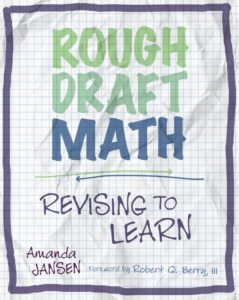Rough Draft Math: Revising to Learn
Rough Draft Math: Revising to Learn
By Amanda Jansen
(Stenhouse Publishers, 2020 – Learn more)
 Reviewed by Michael Hernandez
Reviewed by Michael Hernandez
“Who has the answer to number 1?” (Crickets) “OK. Let’s come back to that one. Who has a solution for problem #2?” One student hesitantly raises her hand. It is the same student who always has the solution and always raises her hand. You always call on her because no one else is willing to volunteer an answer. How you wish that all students would participate!
Does any of this sound familiar? I am certain that Math classes experience this situation much more frequently than other subjects. One reason is that students believe there is one and only one correct solution. And no one wants to be wrong.
 Here is what one student said: “If I don’t understand things, I’m not going to raise my hand and blurt out answer. I think one big problem with me is I’m afraid that the answer’s wrong. I don’t want to be embarrassed by having a wrong answer.”
Here is what one student said: “If I don’t understand things, I’m not going to raise my hand and blurt out answer. I think one big problem with me is I’m afraid that the answer’s wrong. I don’t want to be embarrassed by having a wrong answer.”
This student is not alone. Author, professor and former middle school math teacher Amanda Jansen understands. Mandy listened. That is why she has written, Rough Draft Math: Revising to Learn.
What is “Rough Draft Thinking”?
Mandy describes it this way: “Rough draft thinking happens when students share their unfinished, in-progress ideas and remain open to revising those ideas.”
In her book, she gives numerous examples of rough draft thinking. In chapter 2, she begins doing something that got me really excited, explaining “how-to.” How to develop a classroom culture and environment that encourages rough draft thinking. How to provide tasks and projects that are opportunities for rough draft thinking. How to help students shift from a perfect performance mentality to one that values the process of “revising to learn.”
And she does not just present a “one size fits all” plan. She offers several options for different learning styles of both teachers and students. She also suggests different ways of implementation depending on classroom personalities and topics under discussion.
The author shows that through this emphasis on revising to learn rather than performing to impress, students gain self-confidence. Self-confidence is incredibly important in the learning of mathematics. Students are encouraged not only to share their in-progress thinking, but to listen and learn from other students’ in-progress thinking.
A book for veterans and rookies alike
I recommend this book for all math teachers, both veteran and rookie. Everyone can benefit from the insights presented. Though it was written with a particular view towards grades 4-10, the principles and procedures would most assuredly work in all grades.
I read this book with great anticipation. Personally, I was weary of the same students or no students responding during class discussion. Occasionally I had students who grew in their self-confidence and corresponding math proficiency, but it seemed that happened far too infrequently and a bit randomly. I wanted it to happen regularly and on purpose.
I was excited and ready to put many of these ideas into immediate practice in my classroom. And then COVID-19 struck. Not being super tech-savvy, I did not know how to easily put these plans into practice via remote (distance) learning. (I am sure that this is possible with a little assistance from my Google master colleagues. I may find out in the fall.)
My hope is that, when we return to normal classrooms in school, my class will no longer be normal. It will be filled with rough-draft thinking, all students participating. Students who are not only willing to share responses but are excited to hear other perspectives about how to learn and solve math problems. It will be a fun place and a safe place to make mistakes and grow.
Michael Hernandez is an eighth grade Math and Algebra teacher near Akron, Ohio. He has served on the Ohio Math Model Curricula and Content Advisory Committees. He began his career working with middle school, high school and college students. Through the years, he was “promoted” to the point where his time was spent mostly with adults. Now he is back with the young people he loves. He has been teaching in the public schools for 11 years.

































